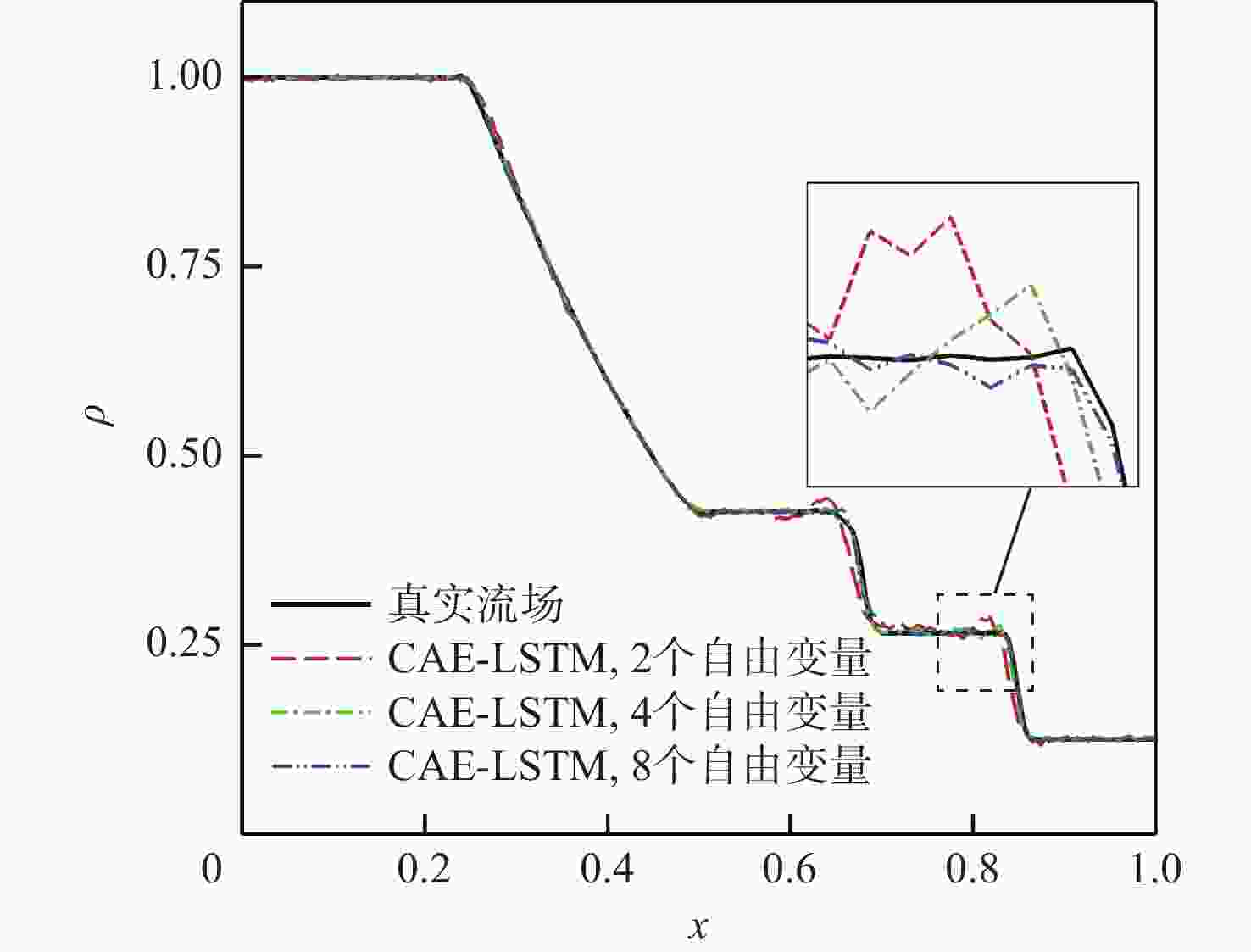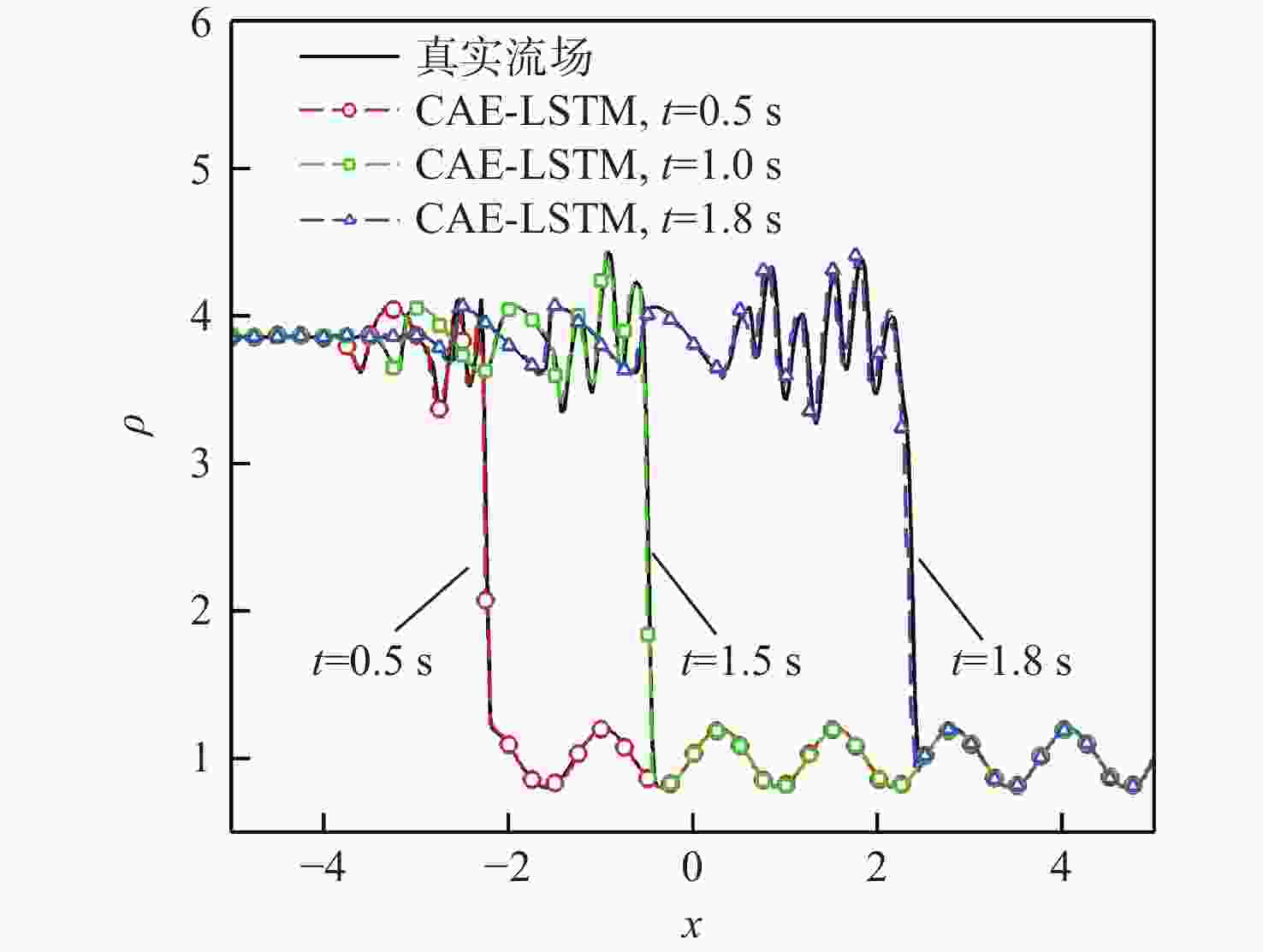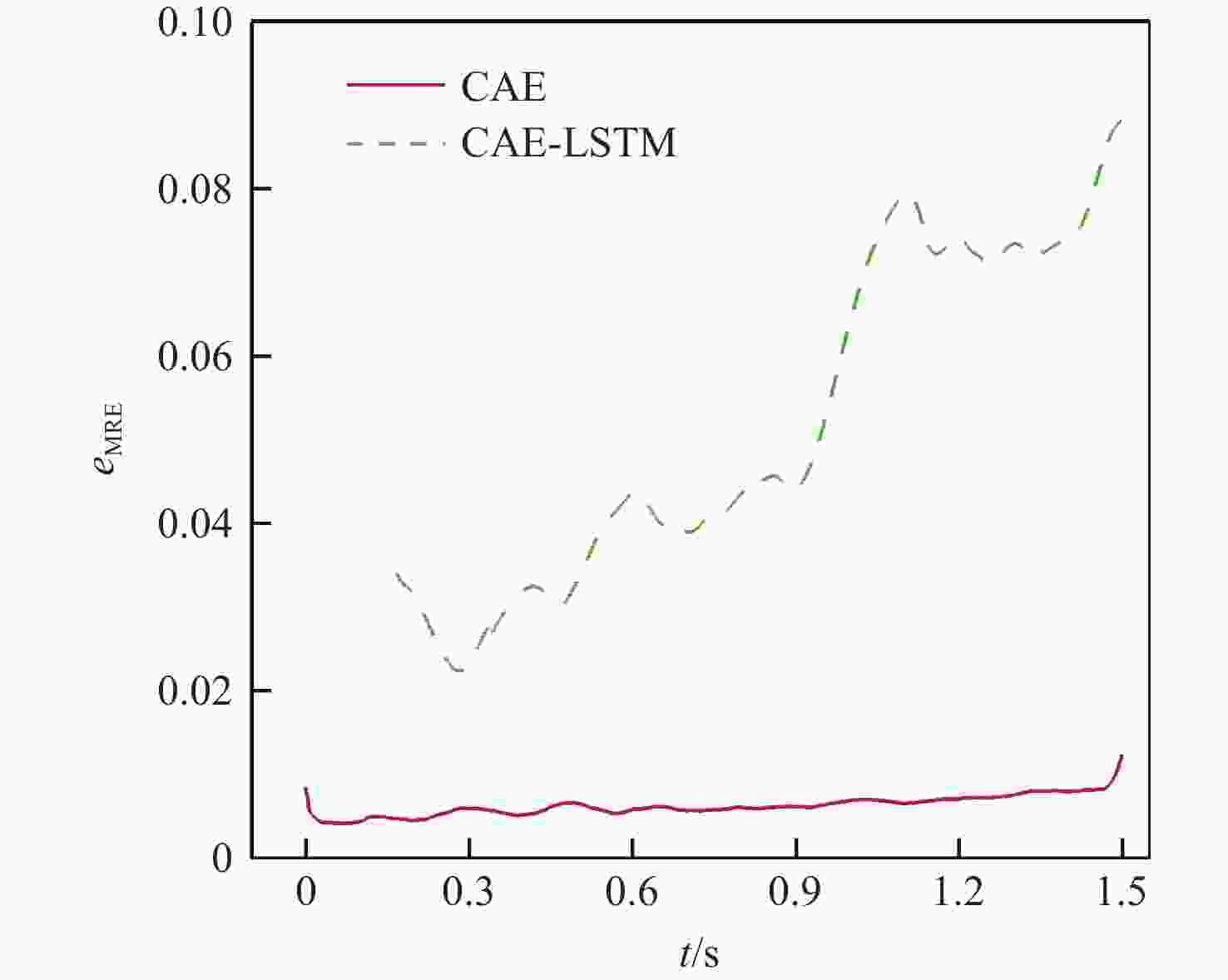Applicability of convolutional autoencoder in reduced-order model of unsteady compressible flows
-
摘要:
为有效降低使用计算流体力学(CFD)方法的设计成本和周期,降阶模型(ROM)得到广泛关注。对于复杂的可压缩流动,使用本征正交分解(POD)等线性方法进行流场降维,需要大量模态才能保证流场重建的精度,采用非线性降维方法能够有效减少所需模态数。卷积自编码器(CAE)是一种由编码器和解码器组成的神经网络,能够实现数据降维和重构,可看作是POD方法的非线性拓展。采用CAE进行流场数据的非线性降维,同时使用长短期记忆(LSTM)神经网络进行流场状态的时间演化。对于不可压缩问题,使用自编码器和LSTM结合进行流场重构的方法已有较多研究,选择一维Sod激波管、Shu-Osher问题、二维黎曼问题和开尔文-亥姆霍兹不稳定性算例,测试该ROM对非定常可压缩流动的有效性,同时基于POD方法,在不同模态数下构造Sod激波管和黎曼问题的ROM作为对比。结果表明:对于非定常可压缩流动,CAE-LSTM方法能够在使用较少自由变量数的前提下获得较高的重构和预测精度。
Abstract:To effectively reduce the design cost and cycle time of using computational fluid dynamics (CFD) methods, the reduced-order model (ROM) has gained wide attention in recent years. For complex compressible flows, using linear methods such as proper orthogonal decomposition (POD) for flow field dimensionality reduction requires a large number of modes to ensure reconstruction accuracy. It has been shown that the mode number can be effectively reduced by using nonlinear dimensionality reduction methods. Convolutional autoencoder (CAE) is a neural network composed of the encoder and decoder, which can realize data dimensionality reduction and reconstruction, regarded as a nonlinear extension of POD method. CAE is used for nonlinear dimensionality reduction, and long short-term memory (LSTM) neural network is used for time evolution. To address flow incompressibility, the combination of Autoencoder and LSTM for flow field reconstruction has been extensively studied. We examine the one-dimensional Sod shock tube, Shu-Osher problem, two-dimensional Riemann problem and Kelvin-Helmholtz instability problem to test the validity of the ROM for unsteady compressible flows. The ROMs of Sod shock tube and Riemann problem are constructed based on POD by different modes for comparison. The results show that CAE-LSTM method can obtain high reconstruction and prediction accuracy on the premise of using less latents for unsteady compressible flows.
-
-
[1] YU J A, YAN C, GUO M W. Non-intrusive reduced-order modeling for fluid problems: A brief review[J]. Proceedings of the Institution of Mechanical Engineers, Part G:Journal of Aerospace Engineering, 2019, 233(16): 5896-5912. doi: 10.1177/0954410019890721 [2] DOWELL E H, HALL K C, ROMANOWSKI M C. Eigenmode analysis in unsteady aerodynamics: Reduced order models[J]. Applied Mechanics Reviews, 1997, 50(6): 371-386. doi: 10.1115/1.3101718 [3] SILVA W A. Identification of linear and nonlinear aerodynamic impulse responses using digital filter techniques[C]//Proceedings of the 22nd Atmospheric Flight Mechanics Conference. Reston: AIAA, 1997: 3712. [4] EIVAZI H, VEISI H, NADERI M H, et al. Deep neural networks for nonlinear model order reduction of unsteady flows[J]. Physics of Fluids, 2020, 32(10): 105104. doi: 10.1063/5.0020526 [5] BENNER P, GUGERCIN S, WILLCOX K. A survey of projection-based model reduction methods for parametric dynamical systems[J]. SIAM Review, 2015, 57(4): 483-531. doi: 10.1137/130932715 [6] 陈刚, 李跃明. 非定常流场降阶模型及其应用研究进展与展望[J]. 力学进展, 2011, 41(6): 686-701. doi: 10.6052/1000-0992-2011-6-lxjzJ2011-009CHEN G, LI Y M. Advances and prospects of the reduced order model for unsteady flow and its application[J]. Advances in Mechanics, 2011, 41(6): 686-701(in Chinese). doi: 10.6052/1000-0992-2011-6-lxjzJ2011-009 [7] 寇家庆. 非定常气动力建模与流场降阶方法研究[D]. 西安: 西北工业大学, 2018: 11.KOU J Q. Reduced-order modeling methods for unsteady aerodynamics and fluid flows[D]. Xi’an: Northwestern Polytechnical University, 2018: 11(in Chinese). [8] 寇家庆, 张伟伟. 动力学模态分解及其在流体力学中的应用[J]. 空气动力学学报, 2018, 36(2): 163-179.KOU J Q, ZHANG W W. Dynamic mode decomposition and its applications in fluid dynamics[J]. Acta Aerodynamica Sinica, 2018, 36(2): 163-179(in Chinese). [9] JIMENEZ L O, LANDGREBE D A. Supervised classification in high-dimensional space: Geometrical, statistical, and asymptotical properties of multivariate data[J]. IEEE Transactions on Systems, Man, and Cybernetics, Part C (Applications and Reviews), 1998, 28(1): 39-54. doi: 10.1109/5326.661089 [10] DEMERS D, COTTRELL G W. Non-linear dimensionality reduction[C]//Advances in Neural Information Processing Systems 5. New York: ACM, 1992: 580-587. [11] MAULIK R, LUSCH B, BALAPRAKASH P. Reduced-order modeling of advection-dominated systems with recurrent neural networks and convolutional autoencoders[J]. Physics of Fluids, 2021, 33(3): 037106. doi: 10.1063/5.0039986 [12] EBDEN M. Gaussian: A quick introduction[EB/OL]. (2015-08-29)[2022-02-24]. https://arxiv.org/abs/1505.02965. [13] SUN G, WANG S Y. A review of the artificial neural network surrogate modeling in aerodynamic design[J]. Proceedings of the Institution of Mechanical Engineers, Part G:Journal of Aerospace Engineering, 2019, 233(16): 5863-5872. doi: 10.1177/0954410019864485 [14] YONDO R, ANDRÉS E, VALERO E. A review on design of experiments and surrogate models in aircraft real-time and many-query aerodynamic analyses[J]. Progress in Aerospace Sciences, 2018, 96: 23-61. doi: 10.1016/j.paerosci.2017.11.003 [15] KUTZ J N. Deep learning in fluid dynamics[J]. Journal of Fluid Mechanics, 2017, 814: 1-4. doi: 10.1017/jfm.2016.803 [16] 张伟伟, 朱林阳, 刘溢浪, 等. 机器学习在湍流模型构建中的应用进展[J]. 空气动力学学报, 2019, 37(3): 444-454.ZHANG W W, ZHU L Y, LIU Y L, et al. Progresses in the application of machine learning in turbulence modeling[J]. Acta Aerodynamica Sinica, 2019, 37(3): 444-454(in Chinese). [17] TOMPSON J, SCHLACHTER K, SPRECHMANN P, et al. Accelerating eulerian fluid simulation with convolutional networks[C]//Proceedings of the 34th International Conference on Machine Leavning. NewYork: ACM, 2017, 70: 3424-3433. [18] LING J, KURZAWSKI A, TEMPLETON J. Reynolds averaged turbulence modelling using deep neural networks with embedded invariance[J]. Journal of Fluid Mechanics, 2016, 807: 155-166. doi: 10.1017/jfm.2016.615 [19] MIYANAWALA T P, JAIMAN R K. An efficient deep learning technique for the Navier-Stokes equations: Application to unsteady wake flow dynamics[EB/OL]. (2018-08-15)[2022-02-24]. https://arxiv.org/abs/1710.09099. [20] 尹明朗, 寇家庆, 张伟伟. 一种高泛化能力的神经网络气动力降阶模型[J]. 空气动力学学报, 2017, 35(2): 205-213.YIN M L, KOU J Q, ZHANG W W. A reduced-order aer ody-namic model with high generalization capability based on neural network[J]. Acta Aerodynamica Sinica, 2017, 35(2): 205-213(in Chinese). [21] 王怡星, 李东风, 陈刚. 一种基于流动特征的气动力深度神经网络降阶模型[C]//第十届全国流体力学学术会议. 北京: 中国力学学会, 2018: 358.WANG Y X, LI D F, CHEN G. A reduced order model of aerodynamic depth neural network based on flow characteristics[C]//The 10th National Conference on fluid mechanics. Beijing: CSTAM, 2018: 358(in Chinese). [22] 武频, 孙俊五, 封卫兵. 基于自编码器和LSTM的模型降阶方法[J]. 空气动力学学报, 2021, 39(1): 73-81.WU P, SUN J W, FENG W B. Reduced order model based on autoencoder and long short-term memory network[J]. Acta Aerodynamica Sinica, 2021, 39(1): 73-81(in Chinese). [23] SIROVICH L. Turbulence and the dynamics of coherent structures[J]. Quarterly of Applied Mathematics, 1987, 45(3): 561-590. doi: 10.1090/qam/910462 [24] LECUN Y, BENGIO Y, HINTON G. Deep learning[J]. Nature, 2015, 521(7553): 436-444. doi: 10.1038/nature14539 [25] HYVÄRINEN A, KÖSTER U. Complex cell pooling and the statistics of natural images[J]. Network:Computation in Neural Systems, 2007, 18(2): 81-100. doi: 10.1080/09548980701418942 [26] ZEILER M D, FERGUS R. Stochastic pooling for regularization of deep convolutional neural networks[EB/OL]. (2013-01-16)[2022-02-24].https://arxiv.org/abs/1301.3557. [27] MATHIEU M, HENAFF M, LECUN Y. Fast training of convolutional networks through FFTs[EB/OL]. (2014-03-06)[2022-02-24].https://arxiv.org/abs/1312.5851. [28] 叶舒然, 张珍, 宋旭东, 等. 自动编码器在流场降阶中的应用[J]. 空气动力学学报, 2019, 37(3): 498-504.YE S R, ZHANG Z, SONG X D, et al. Applications of autoencoder in reduced-order modeling of flow field[J]. Acta Aerodynamica Sinica, 2019, 37(3): 498-504(in Chinese). [29] RAMACHANDRAN P, ZOPH B, LE Q V. Searching for activation functions[EB/OL]. (2017-10-27)[2022-02-24]. https://arxiv.org/abs/1710.05941. [30] HOCHREITER S, SCHMIDHUBER J. Long short-term memory[J]. Neural Computation, 1997, 9(8): 1735-1780. doi: 10.1162/neco.1997.9.8.1735 [31] SCHWANDER L, RAY D, HESTHAVEN J S. Controlling oscillations in spectral methods by local artificial viscosity governed by neural networks[J]. Journal of Computational Physics, 2021, 431(1): 110144. [32] KINGMA D P, BA J. Adam: A method for stochastic optimization[EB/OL]. (2017-01-30)[2022-02-24]. https://arxiv.org/abs/1412.6980. -







 下载:
下载:























